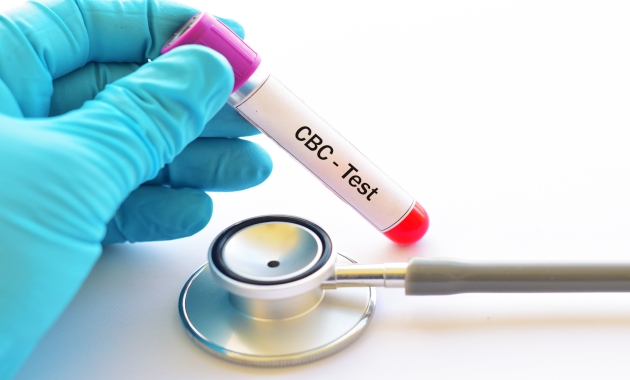
A complete blood count (CBC) is a simple yet crucial blood test which acts as your body’s disease detector. It is one of the most commonly recommended tests that scans through your blood components like red blood cells (RBC), white blood cells (WBC), and platelets to reveal any health issues that your body might be harboring silently. The CBC test also serves as an important inclusion in your routine health check ups. Here’s more on what you must know about the CBC test, its various parameters, who should get tested and when to worry.
Who Should Get A CBC Test?
Anyone can get a complete blood count test done at any time. However, a CBC is usually recommended:
– As a routine preventive health check-up, especially in old age
– In women of reproductive age, especially during and after pregnancy
– For people taking medicines for chronic diseases or chemotherapy
– In case of symptoms of allergy, viral or bacterial infections
– In people with symptoms of constant fatigue, tiredness, weight loss, and reduced appetite
– To monitor disease progression (like in dengue), side effects or response to treatment
– For screening before a surgery or procedure
CBC: How & When Is The Sample Collected?
As CBC is a blood test, you need to give a blood sample. For accurate results, your sample is collected in an EDTA tube which maintains the blood in a fluid state and ensures the cells are preserved for analysis.
The test can be taken at any time of the day. However, if you have high triglyceride levels, then you may be required to fast before giving the sample.
Want to check your triglyceride levels before getting your CBC done? Click here to book your test now!
Understanding CBC Test Details & Ranges
Although there are many parameters tested in a complete blood count, there are a few vital parameters (types) that are mostly looked at to check for an infection or disease. These 7 broad components are:
1. Red blood cells (RBC) & hemoglobin
Your RBCs contain a pigment called hemoglobin which gives the RBCs their characteristic red color. It is responsible for carrying oxygen to various parts of the body. A decrease in hemoglobin or RBC count is called anemia whereas an increase in the RBC count is called polycythemia.
– Low RBC count or hemoglobin level can be due to nutritional deficiency, thalassemia, blood loss or chronic diseases (like kidney failure).
– High RBC count or hemoglobin level can be due to smoking, decreased oxygenation(lung diseases), high altitude, genetic mutations or performance enhancing drugs.
Note: High RBC count can be falsely shown in case of low water content due to dehydration, vomiting, diarrhea, intensive exercise, and diuretics (high BP medicines). Pregnant women can show variation in hemoglobin level due to water retention.
2. Red blood cell indices
This part of the CBC test helps detect anemia and its type. It tells you the amount of hemoglobin present in RBCs and the size of your RBCs. Ideally, your red blood cells are about 7 microns in size.
– Hematocrit or packed cell volume (PCV): Measures the percentage of RBCs present in your blood. A low hematocrit value indicates anemia which occurs when the number of RBCs or their size decreases.
– Mean corpuscular volume (MCV): Measures the mean size of the RBCs. These are usually calculated in the analyzer from the red blood cell count and hematocrit values. Low MCV is usually a sign of iron deficiency whereas high MCV means Vitamin B12 deficiency.
– Red cell distribution width (RDW): RDW is useful to understand the variation in sizes and shapes of RBCs. This helps diagnose anemia and identify the best way to treat it.
3. White blood cells (WBC)
White blood cells are bigger than red blood cells. They are responsible for maintaining the immunity in the body.
Low WBC count or leukopenia may indicate infections, autoimmune disorders, large spleen, or bone marrow diseases. It may also occur due to medications for chronic diseases or cancer.
High WBC count or leukocytosis may indicate infections, inflammation, or blood cancer (leukemia).
4. Differential count
This shows the number of different types of white blood cells. It is expressed in percentage and absolute count. However, absolute counts are usually considered for diagnosis and monitoring treatment response of infections.
– Neutrophils: Increased in bacterial infections
– Lymphocytes: Increased in viral infections
– Eosinophils: Increased in allergic conditions
– Monocytes: Increase in chronic or subacute infections
– Basophils: Increased in chronic inflammation and allergic conditions
5. Platelets
Platelets are responsible for initially stopping the bleeding and play a role in inflammation.
– Low platelet count (thrombocytopenia) can happen in viral infections like dengue, bone marrow diseases, or cancer.
– High platelet count (thrombocytosis) can be seen during infections, inflammation, or while undergoing treatment of iron deficiency anemia.
6. Mean platelet volume (MPV)
This tells the average size of the platelets. It is of significance in thrombocytopenia cases.
CBC Count: When To Worry?
You need immediate medical attention if:
Hemoglobin (Adult): <7 mg/dL and >20 mg/dL
Total leukocyte count (Adult): <2000/cumm and >30,000/cumm
Hematocrit/Packed cell volume (Adult): <20% and >60%
Platelets: <40,000/cumm and >10,00000/cumm
Getting a CBC test as a part of your preventive health check-up or after being advised by your doctor can help you to figure out any infections or disease at the earliest and get it treated.

0Comments